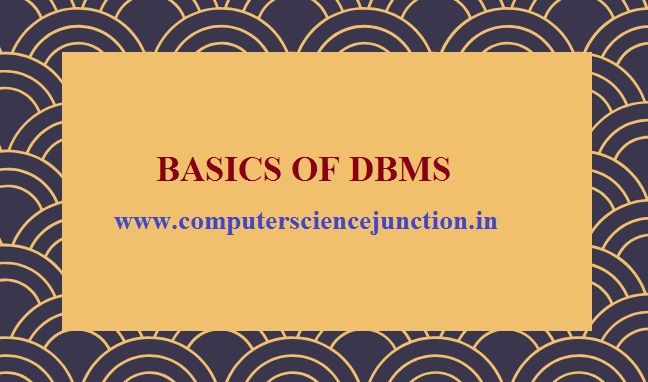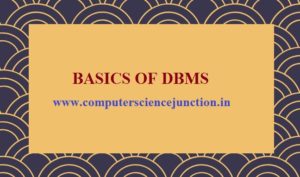Table of Contents
- 1 Characteristics of DBMS and DBMS Introduction
- 1.1 Frequently Asked Questions
- 1.2 What is Data ?
- 1.3 What is Database ?
- 1.4 What is DBMS ?
- 1.5 Why DBMS ?
- 1.6 How does User Interacts with Database ?
- 1.7 Characteristics of DBMS
- 1.8 Example of DBMS
- 1.9 Goals of Database Design
- 1.10 Advantages of DBMS
- 1.11 Disadvantages of DBMS
- 1.12 Data Models in DBMS
- 1.13 Conclusion and Summary
Characteristics of DBMS and DBMS Introduction
Some Important Characteristics and features of DBMS are as follow –
- Reduce redundancy
- Data Consistency
- Security
- Concurrent Access
- Support to SQL
- Transaction Support
Characteristics of Database Management System based this tutorial is specially written for computer science students.
This DBMS Tutorial is helpful in understanding the basics concepts of database such as data definition, database, DBMS introduction, characteristics of DBM and advantages of DBMS.
Database Management System is an important and core subject of Computer Science branch.
Student who want to become a Software Developer or Database Administrator ,they should have good knowledge of DBMS subject.
Questions from DBMS are generally asked in Technical Interview for the post of software engineer or database administrator.
Today in this post we will discuss about basics concepts of database management system including DBMS characteristics.
Latest Update – Python Interview Questions
Frequently Asked Questions
By the end of this DBMS tutorial students will can easily answer of the following questions asked in interview , different exam.
- What is data?
- Write the difference between data and information ?
- Define database?
- What is database management system ?
- Explain various characteristics of DBMS
- What is redundancy in database ?
- Define schema in DBMS..
- What do you understand by the term data consistency ?
- Write advantages and disadvantages of DBMS?
Before introducing the characteristics of DBMS, introduction to database management system , advantages of DBMS , data models in DBMS let us know something about data what is data ?
What is Data ?
- The term data may be defined as a collection of facts which provides information about something.
- Data may be in the form of text, table figure graph audio and video.
- In context of computing data is processed by computer and it is recorded or store in some suitable form which can be understand by the user.
- Data can be stored on secondary device like Hard Disk.
- Data can be collected stored, processed and it can be manipulated it means we can perform some operations on the data. When data is processed then it becomes information.
- Information is nothing but the meaningful data.
What is Database ?
- Database can be simply defined as a collection of data but here we should keep in mind that this data may be interrelated.
- Database is collection of related data.
- Database should be organized in a way such that it It should be easy to update , access and manage the database for the user.
What is DBMS ?
- DBMS is a software or set of programs which helps us in the creation, definition and manipulation of database.
- DBMS allow users to store, process and access the data easily.
Why DBMS ?
- In traditional File System to access the database, User should know about the physical details of data.
- In Traditional File System Operating system fails to handle the concurrency when database is large.
- In Traditional File System once user got access then user can access the whole data.
How does User Interacts with Database ?
- User interacts with DBMS by an interface generally this interface is a command user interface.
- You may also say it as a tool which is used by the user to perform the several operation like creating a database, storing data in the database, updating data, creating tables in the, security.
- User gives the commands on this interface in order to perform these operations.
- Normally SQL Structured Query Language commands are used on most of the database .
DBMS gives the facility to the user to protect the databases used in database management system.
It also provide a way so that multiple user can use the same database. Some widely used DBMS in industry are MySql, Oracle, SQL Server ,IBM DB2.
Characteristics of DBMS
- Reduce Redundancy
- Storing of Data
- Concurrent Access
- Data Consistency
- Transaction Support
- Security
- Support to SQL
1. Way of Storing the data
- In database management system data is stored in from of tables, structure for the table is created initially . This table structure is also known as schema in DBMS.
- Schema in DBMS provides the information about various attributes of name the table , data type of the attribute.
- DBMS a provide a facility to represent a relationship among the related table.
2. Reduced Redundancy
- This is one of the important feature of the DBMS that it reduces the redundancy.
- Here the term redundancy can be seen as unnecessary repetition or duplicacy of data in database .
- To reduce the redundancy DBMS use Normalization in DBMS concept which decompose the given table into smaller tables in order to minimize the redundancy.
Note that DBMS does not guarantee the 100% removal of the redundancy it can only minimize the redundancy.
Also Read –NIST Cloud Computing Reference Architecture
3.Concurrent Access
- DBMS support the concurrent access of the database to the multiple users.
- Multiple users can work on the database at the same time and still maintained the consistency. Here the term consistency represents the correctness of the database.
4. Data Consistency
The term data consistency means state of data should be consistent means it should be correct at any instant of time. Result of any manipulation or updating should be reflected.
6. Security
- DBMS give s the facility to protect the database from unauthorized users.
- Different user s accounts may have different access permissions, using which user can easily secure their data by unauthorized users..
- DBMS supports transactions which helps the user to maintain the integrity of the database.
- Some DBMS software used in software industry are Oracle, MY SQL and SQL server.
Example of DBMS
These DBMS software provide the facility od creating the database and managing the data in from tabular form. Let’s us understand Payroll Management System database.
This database maintains the information about employee of an organization, their monthly salary process. This database contains the following table.
- Employee table Store data of each employee.
- Department Table Store data of each department.
- Project Table store all data about project
- Admin table store the information about administrator login
- Salary Table store the information salary and working hours of the employee
- Deduction table store information about leave and other deduction.
In order to handle the data in database we have to create a database and then create the tables in side that database, applying integrity constraints on the table and then insert the data in related table. Once the data is inserted then we can perform various operation on the data which is stored.
Goals of Database Design
There are three main important goals of a database management system to design an optimized database. These goals are as follow –
- Minimize the redundancy.
- Lossless Join
- Dependency Preservation
If these three features are maintained during database design then database is said to be optimized database.
Advantages of DBMS
These feature of DBMS can also be view as advantages of using DBMS. Some important advantages of DBMS are given below –
- There are several type of methods to store and retrieve the data in database management system.
- Database management system helps in reducing the application development time.
- Database management support transaction processing system.
- DBMS allow concurrent access to data.
- DBMS maintain the integrity and security of data.
Disadvantages of DBMS
When we talk about disadvantages of DBMS then there are no such disadvantages of using DBMS we can see It’s Complexity and cost as a disadvantages and user of DBMS should have good knowledge of database management system and Structured Query Language.
Data Models in DBMS
There are several data models in DBMS such as network model , hierarchical model, relational data model , object oriented data model and ER Data model.
Entity Relationship data model in DBMS is widely used to represent the entities involve in an application and relationship among those entities.
To study complete tutorial of entity relationship diagram student refer this tutorial er diagram examples.
Relational Data Model is an implementable data model and mostly used in database management system software such as Oracle, My SQL, SQL server etc. Relational data model in dbms represents the data in tabular form.
To know more about relational data model in dbms student refer this tutorial relational database management system data models in dbms.
Conclusion and Summary
We have discussed following important points in this tutorial.
- Introduction of data, database and Database Management System
- Characteristics of DBMS
- Advantages and Disadvantages of DBMS
Give your feedback or leave comment so that we can improve the quality of our tutorials and provide you a good quality tutorials.
Note – Link for Some other Important Tutorials of Database Management Subject is given below. Students can study these tutorial and ask their queries.
Database Management System Tutorials
If you find this characteristics of dbms page useful then please Like and Share the post on Facebook, Twitter, Linkedin through their icons as given below.
Next Tutorial – Three Level Database Architecture



